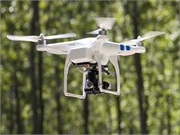Could Drones Delivering Defibrillators Save Lives?
By Cara Roberts MurezHealthDay Reporter

WEDNESDAY, Sept. 16, 2020 (HealthDay News) -- The answer to saving lives from cardiac arrest someday could include sending drones to the rescue.
A recent randomized trial tested whether delivering an automated external defibrillator (AED) by drone would be faster than an ambulance and more accessible for bystanders than looking for AEDs in nearby buildings.
About 350,000 people experience out-of-hospital cardiac arrest each year in the United States, according to the study. Only 10% survive. Though their chance of survival doubles when a bystander administers CPR and defibrillation, bystanders use an AED in only 2% of cardiac arrests.
"They really need to be defibrillated within less than five minutes because every minute that goes by, your chances of survival decrease dramatically," said study co-author Dr. Wayne Rosamond. He's a professor of epidemiology in the Global School of Public Health at University of North Carolina at Chapel Hill.
But the average ambulance arrival according to nationwide statistics is eight minutes and in remote areas possibly 30 minutes, the study said.
"With the development of drone technology, which you read about all the time nowadays, we thought it seemed like a really great application of technology to our public health problem," said Rosamond.
Some European countries have had great success in saturating their communities with AEDs. And in the past two decades, an effort has been made to increase the number of AEDs in U.S. communities, Rosamond said.
"The problem in this country, even though we've increased the number of AEDs, they just aren't used very often. People either don't know where they are or they're afraid to look for one or they're hesitant to try to access one," Rosamond said. "They may be out there, but their utilization is very low."
The randomized trial used GPS technology to deliver AEDs by drone 35 times to five locations on the University of North Carolina campus. The researchers wanted some control of the environment, but in a real-world setting with buildings, power lines, trees and people. Each location presented different conditions and availability of on-the-ground AEDs. Participants were students, staff and faculty.
"The drone successfully found the 'victim' and then landed within 5 feet every time without incident," Rosamond said. "What did matter is that relative to someone running around trying to find an AED on their own, it did make a difference in which got there faster. In most cases, the drone got there faster."
The exception were the tests near the student union, where bystanders found AEDs before the drone AED could arrive, according to Rosamond.
Dr. Ryan Stanton is a spokesperson for the American College of Emergency Physicians. He said he could understand how the technology would be helpful in certain situations, but he sees drone AED delivery as more effective in niche applications than for wide usage.
"I think there are settings where that could be huge. I think potentially in more remote settings, more isolated settings, or even in very congested settings, let's just say rush hour in downtown New York City, where you're having trouble getting folks through," said Stanton, an emergency medicine physician with Central Emergency Physicians in Lexington, Ky.
"For the vast majority of the country, I'm not sure that it's going to be [effective]", Stanton added. "I think it's better to plan and have AEDs in access points where they're close to people already."
The key to increasing overall AED usage would be to ensure they're in well-traveled and obvious locations, Stanton said.
In addition, they need to be reliable. Many AEDs have been in place so long they may need maintenance, Stanton said. He suggested using wireless communication for maintenance notifications.
"We have to make sure that if it's going to be there, that it's going to be ready to work if people need it," Stanton said.
Drone technology is already used for other medical transport, including delivering tissue samples from a hospital to a lab. They're also used to fly vaccines and blood products to rural, hard-to-reach villages in other countries, Rosamond said.
Further studies would need to test other scenarios, including delivery in rural locations, Rosamond said.
"Our goal is to learn from what we did and then hopefully integrate this technology into the real world in existing EMS systems and move it to other parts of the country," Rosamond said.
The study was published Sept. 17 in the New England Journal of Medicine.
More information
There's more on using an AED at the American Red Cross.

The news stories provided in Health News and our Health-E News Newsletter are a service of the nationally syndicated HealthDay® news and information company. Stories refer to national trends and breaking health news, and are not necessarily indicative of or always supported by our facility and providers. This information is provided for informational and educational purposes only, and is not intended to be a substitute for medical advice, diagnosis, or treatment.

